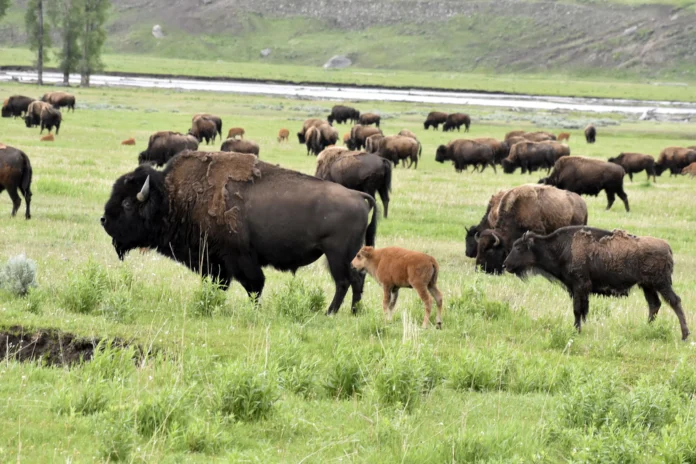Yellowstone National Park, located in the western United States, is known for its breathtaking landscapes and diverse wildlife. Among the many species that call this national park their home, the bison hold a special significance. With their massive horns and iconic brown coats, these majestic creatures have roamed the grasslands of Yellowstone for centuries. A recent study has shed light on the remarkable role that these free-moving herds of migratory bison play in shaping the ecosystem of the park.
Published in the prestigious journal Science, the study has challenged the conventional wisdom of grazing practices and highlighted the positive impacts of large-scale bison migrations. The findings suggest that these migratory animals can help rejuvenate landscapes not just in Yellowstone but also across North America. This discovery comes as a beacon of hope for conservationists, who have been searching for sustainable ways to manage and maintain the health of our natural ecosystems.
The study, conducted by a team of researchers from the University of Wyoming, examined the effects of bison migrations on the grasslands of Yellowstone over a period of six years. They found that when the bison grazed, they disrupted the soil and created small depressions. This, in turn, allowed the seeds of various plant species to penetrate deeper in the soil, resulting in better root growth and healthier vegetation. As a result, the grasslands exhibited a higher level of biodiversity, with more species of plants thriving in the area.
This phenomenon, known as ”tilling effect,” is not new but has largely been ignored in the past. According to the lead author of the study, Jeremey Maestas, “ have been focused on trying to mimic natural disturbance, such as bison,” he said. “But we haven’t necessarily thought about trying to mimic the process by which bison create disturbance.”
The bison’s impact goes beyond just improving the grasslands. Their migration patterns have also been found to have significant correlations with the abundance and diversity of other animals in the park. The study showed that where the bison grazed, there was a higher concentration of small mammals like rodents and lagomorphs, which are a crucial food source for predatory birds and mammals. This, in turn, created a ripple effect throughout the food chain, ultimately benefiting the entire ecosystem.
The study also revealed that the bison’s migratory paths were not random but deliberately chosen to ensure their survival. The herds followed a pattern of moving through various areas of the park, which allowed them to have access to different food sources and minimize competition. This strategy, known as ”swarming,” not only aids in the survival of bison but also helps in sustaining the grasslands’ health.
The results of this study have significant implications for the management of national parks and other protected areas. It presents an alternative approach to the traditional method of intensive grazing used in ranching and other land management practices. By encouraging natural disturbances caused by migratory animals like bison, we can reap the benefits of a diverse and thriving ecosystem.
The findings of this study have sparked a new wave of hope and enthusiasm among conservationists. It highlights the importance of preserving and protecting the migratory routes of these animals, which have been disrupted by human activities in the past. It also calls for a shift in our perspective towards managing and conserving protected areas, by incorporating natural processes such as bison migrations.
However, the authors acknowledge that there are challenges to implementing this approach in other areas and not just Yellowstone. It requires the cooperation and support of various stakeholders, including ranchers and policymakers. Efforts must be made to develop and implement sustainable cattle grazing practices that can complement and coexist with bison migrations.
In conclusion, the latest study on the migratory bison in Yellowstone National Park has provided valuable insights into the role of these magnificent creatures in shaping the ecosystem. It has challenged our established beliefs and opened new avenues for sustainable land management practices. By allowing bison to roam freely and follow their natural migratory patterns, we can witness the rejuvenation of landscapes and the flourishing of diverse flora and fauna not just in Yellowstone but also in other parts of North America. As we work towards preserving and protecting these migratory herds, we are paving the way for a better and healthier future for our planet.

